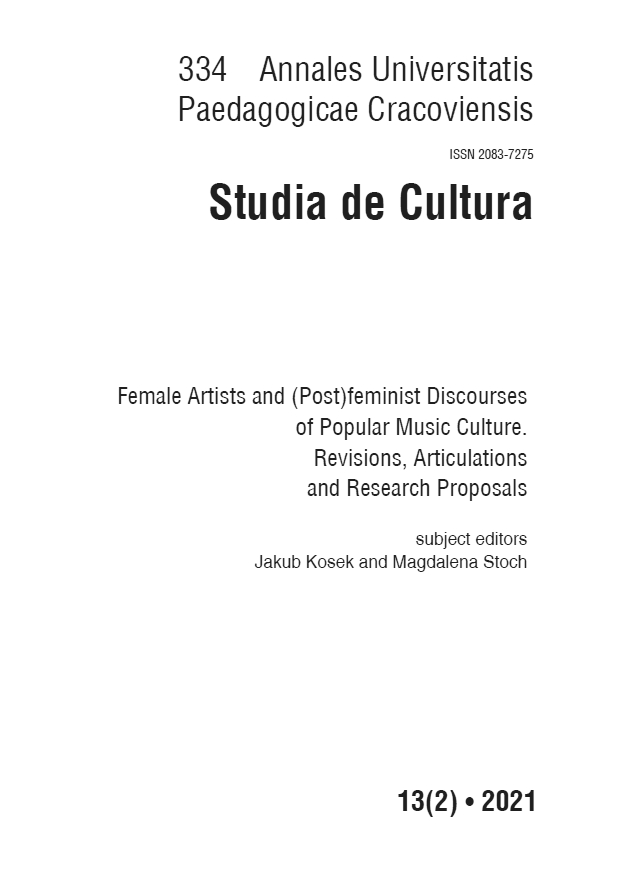Abstrakt
Media muzyczne skonstruowały tożsamość groupies jako obiektów seksualnych i biernych, uległych, nieautentycznych konsumentek muzyki. Stereotyp, choć wciąż jest obecny w kulturze popularnej, spotyka się z krytyką zarówno ze strony samych zainteresowanych, jak i artystów rockowych. W tym artykule podjęto próbę omówienia roli, jaką odegrały groupies w tworzeniu mitu i postaci boga rocka, przy jednoczesnym uwzględnieniu utartych z góry założeń utrwalonych przez popularne media. Uwzględniono narracje z uczestnictwa groupies na budującej się scenie rockowej i metalowej, które stworzyły też osobowość męskiego muzyka rockowego: dzikiego, agresywnego i potężnego. Podstawą dyskusji o groupies i ich roli w budowaniu tożsamości w kontekście muzyki rockowej jest głęboka, retoryczna analiza biografii groupies, materiałów prasowych, filmów, literatury naukowej oraz badania własne.
Bibliografia
Ayres Chris, Osbourne Ozzy. 2014. Ja, Ozzy. Dariusz Kopaciński (transl.). Czerwonak.
Zobacz w Google Scholar
Bozza Anthony, Lee Tommy. 2004. Tommyland. New York.
Zobacz w Google Scholar
Burks John, Hopkins Jerry. 1970. Groupies and Other Girls: A Rolling Stone Special Report. New York.
Zobacz w Google Scholar
Cline Cheryl. 1992. Essays from Bitch: The Women’s Newsletter with Bite. In: The Adoring Audience: Fan Culture and Popular Media. Lisa A. Lewis (ed.) London.
Zobacz w Google Scholar
Davis Steven. 2008. Młot bogów: Saga Led Zeppelin. Marta Szelichowska-Kiziniewicz (transl.). Czerwonak.
Zobacz w Google Scholar
Davies Helen. 2001. “All rock and roll is homosocial: The representation of women in the British rock music press”. Popular Music no. 20(3).
Zobacz w Google Scholar
Des Barres Pamela. 1987. I’m With the Band: Confessions of a Groupie. New York.
Zobacz w Google Scholar
Des Barres Pamela. 1992. Take Another Little Piece of My Heart: A Groupie Grows Up. New York.
Zobacz w Google Scholar
Des Barres Pamela. 2007. Let’s Spend the Night Together. Chicago.
Zobacz w Google Scholar
Frith Simon, Horne Howard. 1987. Art into Pop. New York.
Zobacz w Google Scholar
Frith Simon, McRobbie Angela. 1978. Rock and Sexuality. London.
Zobacz w Google Scholar
Forrest Rebecca. 2010. Mud shark: Groupies and the construction of the heavy metal rock God. In: The Metal Void: First Gatherings. Niall W.R. Scott, Imke Von Helden (eds.). Oxford.
Zobacz w Google Scholar
Forsyth Craig J., Thompson Carol Y. 2007. “Helpmates of the rodeo: Fans, wives and groupies”. Journal of Sports and Social Issues no. 31(4).
Zobacz w Google Scholar
Hill Rosemary L. 2014. “Reconceptualising Hard Rock and Metal Fans as a Group: Imaginary Community”. International Journal of Community Music no. 7(2).
Zobacz w Google Scholar
Karbownik Karolina. 2017. “Seks, śmierć i Steel Panther”. Mystic Art no. 1(66).
Zobacz w Google Scholar
O’Reilly Daragh, Larsen Gretchen, Kubacki Krzysztof. 2013. Music, Markets and Consumption. Oxford.
Zobacz w Google Scholar
Rhodes Lisa. 2005. Electric Ladyland: Women and Rock Culture. Philadelphia.
Zobacz w Google Scholar
Scharrf Virginia. 2003. Twenty Thousand Roads. Women, Movement and the West. Toronto.
Zobacz w Google Scholar
Shepherd John. 1989. Music and male hegemony. In: Music and Society. The Politics of Composition, Performance and Reception. Richard Leppert, Susan McClary (eds.). Cambridge. 152–173.
Zobacz w Google Scholar
Sixx Nikki, Mars Mick, Neil Vince, Lee Tommy, Strauss Neil. 2010. Mötley Crüe. Brud. Michał Kapuściarz (transl). Poznań.
Zobacz w Google Scholar
Straw Will. 1984. “Characterizing Rock Music Culture: The Case of Heavy Metal”. Canadian University Music Review no. 5(5).
Zobacz w Google Scholar
Warwick, J. 2007. “Book review of «Electric Ladyland: Women and Rock Culture» by Lisa L. Rhodes”. American Studies no. 48(1). Philadelphia.
Zobacz w Google Scholar
Weinstein Deena. 2000. Heavy Metal and Its Culture. Boston.
Zobacz w Google Scholar
Whiteley Sheila. 1997. Sexing the Groove: Popular Music and Gender. New York.
Zobacz w Google Scholar
Netography:
Zobacz w Google Scholar
Hilburn Roger. 1969. “Groupie’ Therapy on Rock Scene”. Los Angeles Times. https://latimes.newspapers.com/ (access: 14.09.2020).
Zobacz w Google Scholar
Karbownik Karolina, Annie C. Laviour. „Być jak groupie”. Rock Axxess (15-16) https://issuu.com/rockaxxess/docs/rock_axxess_15-16 (access: 23.08.2020).
Zobacz w Google Scholar
Orloff Kathy 1970. “New Music, New Morality and the Groupie Movement”. Los Angeles Times. https://latimes.newspapers.com/ (access: 14.09.2020).
Zobacz w Google Scholar
Thomas Kevin. 1970. “Groupies. Details Rock Phenomenon” Los Angeles Times https://latimes.newspapers.com/ (access: 14.09.2020).
Zobacz w Google Scholar
Torgeson Dial. 1968. “The New Morality: Is It New or Just in the Open” Los Angeles Times. https://latimes.newspapers.com/ (access: 14.09.2020).
Zobacz w Google Scholar
Filmography:
Zobacz w Google Scholar
Crowe Cameron. 2000. “Almost Famous”, USA.
Zobacz w Google Scholar
Dorfman Rob, Nebard Peter. 1970. “Groupies”, USA.
Zobacz w Google Scholar

Utwór dostępny jest na licencji Creative Commons Uznanie autorstwa – Użycie niekomercyjne 4.0 Międzynarodowe.

